 Home
Home
 Back
Back

Definition: The Mean, Median, Mode Calculator computes the arithmetic mean, median, and mode to summarize the central tendency of a dataset.
Purpose: This tool is used in statistics to describe data distribution, identify typical values, and support further analysis in research, education, and data science.
The calculator uses the following formulas:
\( \mu = \frac{\sum X}{N} \quad \text{(Mean)} \)
\( \text{Median} = \begin{cases} x_{\frac{n+1}{2}} & \text{if } n \text{ is odd} \\ \frac{x_{\frac{n}{2}} + x_{\frac{n}{2}+1}}{2} & \text{if } n \text{ is even} \end{cases} \)
\( \text{Mode} = \text{most frequent value(s)} \)
Where:
Steps:
These measures are essential for:
Example: Calculate mean, median, and mode for the dataset: [2, 5, 6, 8, 9].
Q: What is the mean?
A: The mean is the arithmetic average, calculated as the sum of values divided by the number of values.
Q: How is the median different from the mean?
A: The median is the middle value (or average of two middle values) in a sorted list, less affected by outliers than the mean.
Q: What if there is no mode?
A: If all values appear with the same frequency (e.g., once), the mode is reported as "None".